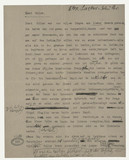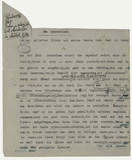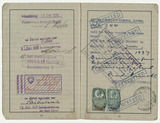Else Lasker-Schüler: Chaluzim kommen aus den Orangenhainen (c. 1935)
Prince Jussuf and his friends come to lifeElse Lasker-Schüler was in exile in Switzerland from April 1933. Her drawings were removed from the Berlin National Gallery in the wake of the "Degenerate Art" policy in 1937.
Else Lasker-Schüler: Drawing of Die verscheuchte Dichterin (presumably between 1935-1942)
This drawing, one of the last by the poet, can be seen as a resume of Else Lasker-Schüler’s life in exile. The ficticious comment about the origin being 1933, with the unique quotation from the poem Müde and the motif itself, depicts the poet herself as she seeks support and consolation from an oriental-looking man.
Else Lasker-Schüler: Letter to Emil Raas (1939)
In 1939, the poet Else Lasker-Schüler took her third trip to Palestine. She intended to return to Switzerland, as she normally did.
Else Lasker-Schüler: Mein blaues Klavier, first edition (1943)
The last book published by the Prince of ThebesElse Lasker-Schüler's last book, Mein blaues Klavier, was published in 1943 in a print run of 330 copies, one and a half years before her death. A collection of poems in which the poet found haunting words for her life in exile and her grief for everything that had been lost.
Else Lasker-Schüler: Obeisances (about 1940)
This is a rather unique text from the poet’s collections in its confident lightness. Else Lasker-Schüler, in an almost aphoristic manner, describes some of the personalities of Jerusalem in the early 1940s.
Else Lasker-Schüler: Obituary for Ernst Toller (1939)
When the author and one time social revolutionary Ernst Toller took his life in his New York exile in May 1939, it caused a stir with many other exiles. Toller’s suicide was motivated mainly by the despair about the growing facism in Europe and the resulting hoplessness.
Else Lasker-Schüler: Typescript: Hebräerland, 1935
The prose piece "Das Hebräerland" by the poet Else Lasker-Schüler, is the most comprehensive piece that she wrote throughout her exile since 1933. She was enthralled by her first trip to Palestine, which she took during her Swiss exile in 1934.
Else Lasker-Schüler’s passport
Else Lasker-Schüler had been in Swiss exile since 1933. She was only granted leave to remain and her hopes of receiving a residence permit remained unfulfilled. This situation lasted for over six years.
Emil Ludwig, Resident Alien’s Identification Card, 1944
Ludwig’s years of exile in the USAFrom 1906, Emil Ludwig lived in Moscia, in the Swiss municipality of Ascona. After becoming a Swiss citizen in 1932, he spent the first years of the Nazi dictatorship in Switzerland.
Emine Sevgi Özdamar, reading from Die Brücke vom Goldenen Horn (The Bridge of the Golden Horn), 1992
From Istanbul to the women's hostel in Berlin Emine Sevgi Özdamar reads the beginning of Die Brücke vom Goldenen Horn (1992, englisch: The Bridge of the Golden Horn, 2007). It is 1966, and the eighteen-year-old Özdamar, who tells her story in the first person, has just travelled from Turkey to work in a radio factory in Berlin.











